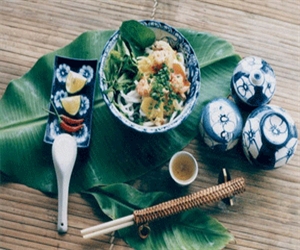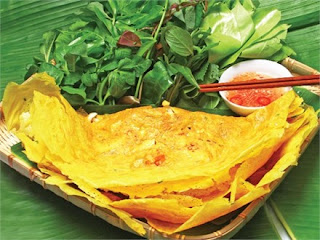Canh chua (literally "sour soup") is a sour soup indigenous to the Mekong Delta region of southern Vietnam. It is typically made with fish from the Mekong River Delta, pineapple, tomatoes (and sometimes also other vegetables such as okra or bạc hà), and bean sprouts, in a tamarind-flavored broth. It is garnished with the lemony-scented herb ngò ôm (Limnophila aromatica), caramelized garlic, and chopped scallions, as well as other herbs, according to the specific variety of canh chua; these other herbs may include rau răm (Vietnamese coriander), ngò gai (long coriander), and rau quế (Thai basil).
The sour taste of the soup comes from tamarind, which is mixed with a small amount of hot water; the mixture is then stirred for a few moments to release all the essence, and the liquid (minus the tamarind seeds and other solids, which are discarded) is then added to the soup.
When made in style of a hot pot, canh chua is called lẩu canh chua.
The sour taste of the soup comes from tamarind, which is mixed with a small amount of hot water; the mixture is then stirred for a few moments to release all the essence, and the liquid (minus the tamarind seeds and other solids, which are discarded) is then added to the soup.
When made in style of a hot pot, canh chua is called lẩu canh chua.
When it comes to canh chua (literally means “sour soup”) most people are familiar with canh chua cá (sour fish soup). There are many different variations to canh chua. Some are cooked with bamboo, eel, chicken, pork ribs or prawns. Undoubtedly the original cooked with fish, tamarind, pineapples, elephant ears, tomatoes and okra is the still the best.
Another version of canh chua my mum usually makes is with prawns and water spinach. My husband much prefers this one because he finds the fish one too fishy. Tamarind is use to give the sour taste in canh chua. I would much prefer to use fresh tamarind for this soup but since I can’t get fresh tamarind I used a tamarind sour soup powder (which has a lot of other seasoning in it).
Another version of canh chua my mum usually makes is with prawns and water spinach. My husband much prefers this one because he finds the fish one too fishy. Tamarind is use to give the sour taste in canh chua. I would much prefer to use fresh tamarind for this soup but since I can’t get fresh tamarind I used a tamarind sour soup powder (which has a lot of other seasoning in it).
Garnishing canh chua with rice paddy herb (ngò om) and saw tooth coriander (ngò gai) really enhances this dish (don’t you just love the names of these herbs). This herb is called saw tooth herb. It has a very strong taste and smell which is hard to describe. My parents have an abundance of this herb growing in their backyard.














































